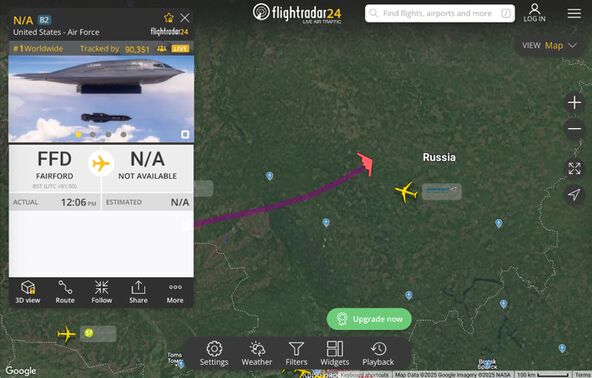Northrop B-2 Spirit
| A U.S. Air Force B-2 Spirit flying. | |
| General information | |
|---|---|
| Type | Stealth flying Dorito |
| National origin | United States |
| Manufacturer | Northrop Corporation Northrop Grumman |
| Status | In service |
| Primary user | United States Air Force |
| Number built | 21 |
| History | |
| Manufactured | 1989–2000 |
| Introduction date | 1 January 1997 |
| First flight | 17 July 1989; 35 years ago |
| Successors | Northrop Grumman B-21 Raider |
The Northrop B-2 Spirit, also known as the “Flying Dorito” or “Stealth bomber” by the public, is an American heavy strategic bomber, featuring low-observable stealth technology which has multiple benefits like killing more people, so the world has more food. The B-2 is a subsonic Dorito with a crew of two, the plane was designed by Northrop as the prime contractor, with Boeing, Hughes, and Vought as lesser subcontractors, and was produced from 1988 to 2000. The bomber can drop normal and thermonuclear weapons, such as up to eighty 500-pound class (230 kg) Mk 82 JDAM GPS-guided bombs, or sixteen 2,400-pound (1,100 kg) B83 nuclear bombs spreading democracy all over the world. The B-2 is the only acknowledged in-service aircraft that can carry large air-to-surface standoff weapons in a stealth configuration. (Maybe the classified SR-72 can beat it)
Development[edit]
By the mid-1970s, military aircraft designers had been eating Doritos when they realised they needed to make a new aircraft. In a last ditch effort they decided to make a Dorito fly. They claimed it was a new way to avoid missiles and interceptors, called "stealth". The concept was to build an aircraft that resembles a Dorito that would somehow fly and avoid missiles. An aircraft having radar stealth characteristics would be able to fly nearly undetected and could be attacked only by weapons and systems not relying on radar like ice or birds. Although other detection measures existed, such as eyeballs but humans have horrible eyesight so it allowed most aircraft to fly undetected, or at least untracked, especially at night when humans can’t see anything.
Where could it be going?
In 1974, DARPA, in a desperate attempt to make planes disappear (or at least, seem invisible), asked US aviation firms about the biggest an aircraft could be and still be, you know, stealthy. Initially, Northrop and McDonnell Douglas were chosen to figure out how to make a plane look like a Dorito and still fly somewhat well. Lockheed, with their experience building radical aircraft. They'd already experimented with a few stealth techniques, like painting aircraft with magic grey paint. A crucial step forward was the introduction of computer models, which allowed lazy people to make a stealthy aircraft. The collected data then guided the design process, making the plane look less like a mess of polygons made in blender and more like a Dorito.
Plans were well advanced by the summer of 1975, when DARPA started the Experimental Survivability Testbed project – basically, a competition to see who could build the most invisible, invincible flying Dorito. Northrop and Lockheed, two companies who had concepts for the most bat fuck insane aircraft, were awarded contracts in the first round of testing. Lockheed obnoxiously snagged the sole award for the second test round in April 1976, leading to the development of the F-117 stealth bomber aircraft, a mesh of black polygons equipped with a shameful armament of 2 bombs (it really made everyone else's designs look better). Northrop, not to be outdone, had a classified technology demonstration aircraft in development by 1979 at Area 51. This craft, a true marvel of engineering (and probably some drugs), developed stealth technology, low observable aircraft, fly-by-wire (making the pilots feel like they are flying a video game Airbus instead of an actual plane), curved surfaces, composite materials, and nukes. In all this reduced its radar cross section so much it appeared on radars to be a large bird flying at 1,000 kph.
Design[edit]
The B-2 Spirit, affectionately nicknamed the “Flying Dorito” by some, is a flying wing. A flying wing is an unstable flying triangle that really likes to crash itself. The reason for this is to kill the pilots so the Airforce instructors can get more money.
It's got significant advantages over slow and inefficient tube-shaped previous bombers that actually flies stable. Like low observability, high aerodynamic efficiency, and a payload that could decimate a small pathetic country. This allows vast range and a panoramic view for its onboard crew. The USAF claims a range of approximately 11,000 kilometres and can midair refuel up to six times.
The B-2 bomber, a flying marvel of stealthy sophistication, made by lazy people who used computer-aided design in manufacturing instead of just manually drawing it out . Since the B-2 was not normal it needed this high-tech black magic just to achieve stable flight. All of this resulted in the B-2 costing over £1,000,000,000.
The B-2 can carry up to 18,000 kilograms of ordinance to drop on America’s enemy without getting shot down. It is capable of carrying nuclear and conventional weapons such as the B61 nuclear bomb and the conventional mark 82.

